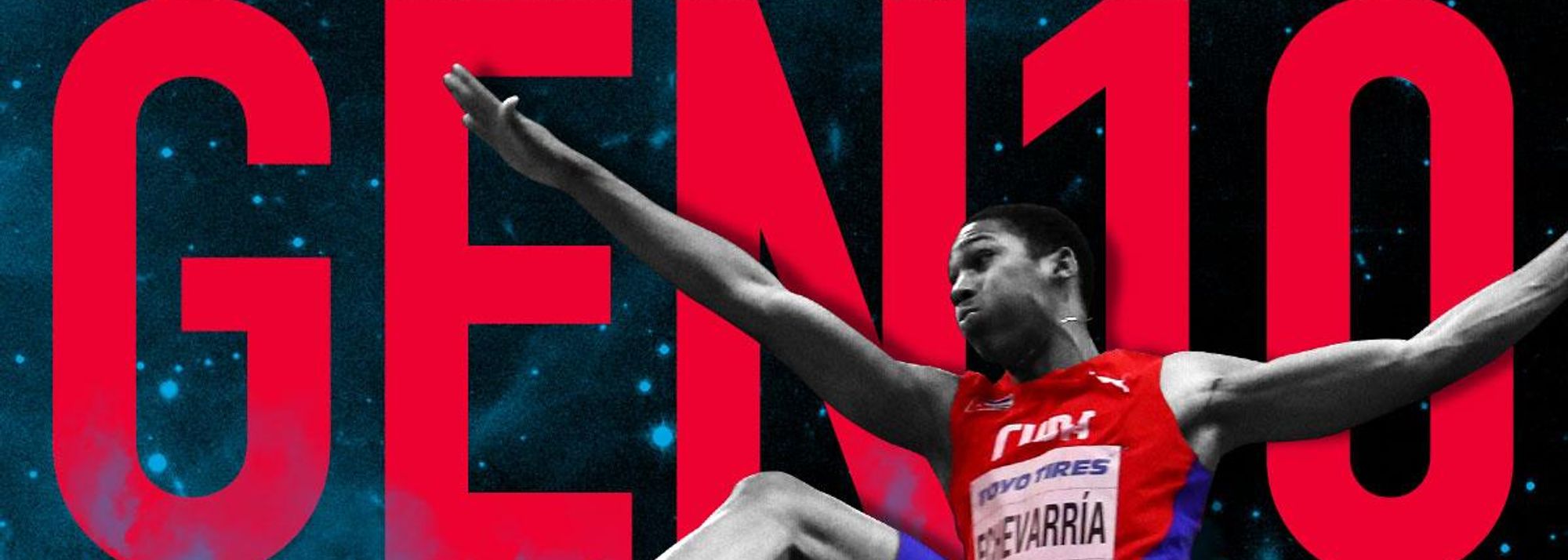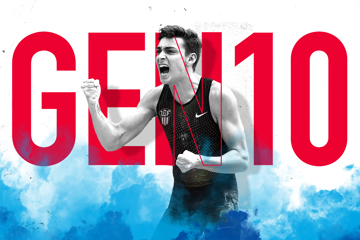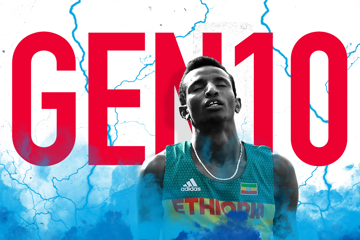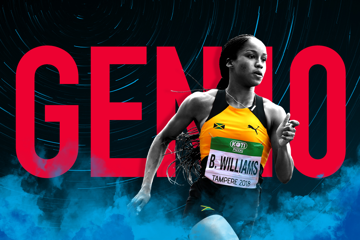Gen Ten: Cuban long jumper Juan Miguel Echevarria (© Getty Images)
Looking ahead to the IAAF World Athletics Championships Doha 2019 and the Tokyo 2020 Olympic Games, we're highlighting the rise of a new generation, 10 exciting prospects under the age of 21 who are set to become stars of the sport over the next few years.
The series, which runs Monday through Friday this week and next, began with Sweden's Armand Duplantis, the world U20 record holder in the pole vault and continued with world U20 400m hurdles record-holder Sydney McLaughlin, world U20 5000m record-holder Selemon Barega and world U20 double sprint champion Briana Williams.
Our series continues with Cuba’s 20-year-old long jumper Juan Miguel Echevarria who captivated the sport world's imagination with his wind-assisted 8.83m leap in Stockholm in June, the farthest jump in the world in nearly 24 years.
Profile: Juan Miguel Echevarria
Country: Cuba
Event: Long jump
Born: 11 August 1998
Coach: Daniel Osorio
Social media: @juanmiguelechevarri (Instagram)
When he sailed to his long jump victory at the IAAF Diamond League meeting in Stockholm last June, Juan Miguel Echevarria almost jumped out of the pit. It’s no surprise then that after that mammoth 8.83m leap, the farthest in the world for nearly 24 years, talk of a world record assault would shadow the young Cuban’s every subsequent appearance.
Unfortunately for Echevarria, a 2.1m/s tailwind on the jump in the Swedish capital was just above the allowable 2.00m/s wind limit for record purposes, but it still landed him among the top five of all time in all conditions and in the company of some of the great legends of the sport, including world record-holder Mike Powell (8.95m), four-time Olympic champion Carl Lewis (8.87m) and former world record-holder Bob Beamon (8.90m). Just 20, Echevarria has ample time to surpass those legends.
After jumping 7.47m at age 15 in 2014, Echevarria first came to prominence in 2015 when he produced his first eight-metre jump. Aged 16, he leaped 8.05m in Havana on 15 May, putting him equal fifth on the world U18 all-time list at that time. At the World U18 Championships in Cali later that year - his first competition outside Cuba - he finished just outside the medals in fourth, seven centimetres shy of bronze. He ended the year on a high, winning the Pan-American junior title in Edmonton.
Echevarria opened his 2016 season with a wind-assisted leap of 8.15m. He finished fifth at the 2016 World U20 Championships later that year, just 10 centimetres shy of a medal.
Still an U20 athlete, he improved in 2017 with PBs of 8.19m and 8.28m, moving to equal seventh on the world U20 all-time list at that time. He represented Cuba at the IAAF World Championships London 2017 but missed out on making the final by five centimetres.
In 2018, his first year as a senior although still a teenager, Echevarria made his indoor debut. He won at the IAAF World Indoor Tour meeting in Karlsruhe and then set an outright lifetime best of 8.34m in Metz. Less than a month later, he produced one of the biggest upsets at the IAAF World Indoor Championships Birmingham 2018 by winning gold with 8.46m, beating world champion Luvo Manyonga in an enthralling head-to-head battle.
His progress continued outdoors. He jumped 8.40m back home in Cuba before improving to 8.53m at the IAAF Diamond League meeting in Rome, where he finished a close second to Manyonga. Up against his South African rival once again in Stockholm, Echevarria had the competition won with an 8.50m leap but then sailed out to his wind-assisted 8.83m in the final round. Nineteen at the time, Echevarria was not born the last time that someone jumped farther than he did in Stockholm – when Powell jumped 8.95m at high altitude in Sestriere, Italy, on 31 July 1994, with a huge 3.9m/s tailwind.
His momentum continued later into the month with 8.66m and 8.68m personal bests in Ostrava and Bad Langensalza, Germany, respectively. On 5 July he reached 8.34m at a meeting in Guadalajara, Spain, to collect his eighth victory in 10 starts this year, before a minor injury setback ended his season.
10 facts about Echevarria
1. He started doing athletics at school when he was seven, and kept on improving in the age groups.
“When I was 12 I started to focus on the long jump and triple jump. I wasn’t very good at the triple jump.“
2. As a young athlete his performances would suffer because he had trouble concentrating.
“I had problems with my mental control. I was very hyperactive and I didn’t focus enough on competition.”
3. He didn’t become “the real Echevarria” until last year – and in sad circumstances.
“There was a change in my life in 2017 when my mother Luciana passed away. This changed things for me, this was when the real Echevarria emerged and I started to focus more and have some really good results.
My mother was everything for me, she gave me life, together with my father she raised me and my siblings. Sometimes the times were hard. Sometimes I was not always ready to work, didn’t like getting up in the morning to train.
“But she was always there pushing me, motivating me. I’m the person I am now thanks to her. I do hope she is now happy with all I am achieving. It really is all thanks to my mother.”
4. He has competed now against some of his idols, and being beaten by them is something he uses positively.
“I don’t think of them as competitors, but athletes I could learn from. This has been my path in athletics.”
5. He doesn’t believe that any world records should be archived and re-set because of doubts about their integrity.
“We must recognise them for the extraordinary performances they are. The world record is always set by an extraordinary person. This is what inspires us and gives us the motivation to try and catch it.”
“The women’s long jump world record is very far, but the men’s is closer. And we have a very good crop of athletes out there to get it.”
6. His 8.83m long jump this year – the farthest effort seen in 23 years – had a wind reading of 2.01 metres per second. That’s 0.1 mps too strong for record purposes. But he’s encouraged rather than frustrated.
“No I am happy with it because it’s really a great mark and everybody would be happy to jump 8.83. For me it’s a good feeling that I have and I will do everything I can to jump it regularly and to do even more.”
7. He doesn’t have any pre-competition rituals – but he doesn’t switch on until the last minute.
“I have never felt the need to have a ritual, but what is important for me is to forget the competition until the moment when I am there, and then I really have to focus on it.”
8. He thinks athletes are often under-appreciated.
“A lot of people don’t realise how much effort goes into being an athlete. That is why some people who are outside the sport, if you have a performance that is not very high, they start to criticise you. They don’t realise just how hard it is.”
9. Sorry, but he didn’t write “9.00 metres” on his wall as a child
“I didn’t write 9.00 metres anywhere. But it is on my mind. I don’t set myself marks for a competition I just try to give my best and to improve all the little mistakes so I can go further.”
10. His 17-year-old fellow Cuban athlete Jordan Diaz, the world under-20 and Youth Olympic Games triple jump champion, says Echevarria is “like a brother”.
“We spend a lot of time hanging around together. We have both achieved great results at a very young age. This has always been on my mind. We have been improving together.”
Top five long jump performers of all time (wind legal)
8.95 Mike Powell (USA) Tokyo, 1991
8.90 Bob Beamon (USA) Mexico City, 1968
8.87 Carl Lewis (USA) Tokyo, 1991
8.86 Robert Emmiyan (ARM) Tsakhkadzor, 1987
8.74 Larry Myricks (USA) Indianapolis, 1988
Top five long jump performers of all time (wind assisted)
8.99 Mike Powell (USA) Sestriere, 1992
8.91 Carl Lewis (USA) Tokyo, 1991
8.83 Juan Miguel Echevarria (CUB) Stockholm, 2018
8.79 Ivan Pedroso (CUB) Havana, 1992
8.78 Fabrice Lapierre (AUS) Perth, 2010








